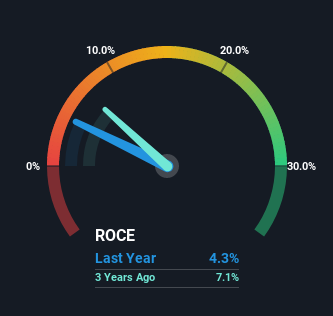- Saudi Arabia
- /
- Gas Utilities
- /
- SASE:9516
Returns On Capital Signal Difficult Times Ahead For Natural Gas Distribution (TADAWUL:9516)
What underlying fundamental trends can indicate that a company might be in decline? Typically, we'll see the trend of both return on capital employed (ROCE) declining and this usually coincides with a decreasing amount of capital employed. This combination can tell you that not only is the company investing less, it's earning less on what it does invest. In light of that, from a first glance at Natural Gas Distribution (TADAWUL:9516), we've spotted some signs that it could be struggling, so let's investigate.
What Is Return On Capital Employed (ROCE)?
For those who don't know, ROCE is a measure of a company's yearly pre-tax profit (its return), relative to the capital employed in the business. Analysts use this formula to calculate it for Natural Gas Distribution:
Return on Capital Employed = Earnings Before Interest and Tax (EBIT) ÷ (Total Assets - Current Liabilities)
0.043 = ر.س2.7m ÷ (ر.س92m - ر.س30m) (Based on the trailing twelve months to June 2022).
Therefore, Natural Gas Distribution has an ROCE of 4.3%. In absolute terms, that's a low return and it also under-performs the Gas Utilities industry average of 8.2%.
Check out our latest analysis for Natural Gas Distribution

While the past is not representative of the future, it can be helpful to know how a company has performed historically, which is why we have this chart above. If you're interested in investigating Natural Gas Distribution's past further, check out this free graph of past earnings, revenue and cash flow.
What Can We Tell From Natural Gas Distribution's ROCE Trend?
We are a bit worried about the trend of returns on capital at Natural Gas Distribution. To be more specific, the ROCE was 5.9% four years ago, but since then it has dropped noticeably. On top of that, it's worth noting that the amount of capital employed within the business has remained relatively steady. Since returns are falling and the business has the same amount of assets employed, this can suggest it's a mature business that hasn't had much growth in the last four years. So because these trends aren't typically conducive to creating a multi-bagger, we wouldn't hold our breath on Natural Gas Distribution becoming one if things continue as they have.
While on the subject, we noticed that the ratio of current liabilities to total assets has risen to 32%, which has impacted the ROCE. Without this increase, it's likely that ROCE would be even lower than 4.3%. Keep an eye on this ratio, because the business could encounter some new risks if this metric gets too high.
The Bottom Line On Natural Gas Distribution's ROCE
In summary, it's unfortunate that Natural Gas Distribution is generating lower returns from the same amount of capital. Long term shareholders who've owned the stock over the last year have experienced a 45% depreciation in their investment, so it appears the market might not like these trends either. With underlying trends that aren't great in these areas, we'd consider looking elsewhere.
If you'd like to know more about Natural Gas Distribution, we've spotted 3 warning signs, and 2 of them don't sit too well with us.
While Natural Gas Distribution may not currently earn the highest returns, we've compiled a list of companies that currently earn more than 25% return on equity. Check out this free list here.
Valuation is complex, but we're here to simplify it.
Discover if Natural Gas Distribution might be undervalued or overvalued with our detailed analysis, featuring fair value estimates, potential risks, dividends, insider trades, and its financial condition.
Access Free AnalysisHave feedback on this article? Concerned about the content? Get in touch with us directly. Alternatively, email editorial-team (at) simplywallst.com.
This article by Simply Wall St is general in nature. We provide commentary based on historical data and analyst forecasts only using an unbiased methodology and our articles are not intended to be financial advice. It does not constitute a recommendation to buy or sell any stock, and does not take account of your objectives, or your financial situation. We aim to bring you long-term focused analysis driven by fundamental data. Note that our analysis may not factor in the latest price-sensitive company announcements or qualitative material. Simply Wall St has no position in any stocks mentioned.
About SASE:9516
Natural Gas Distribution
Distributes natural gas through pipelines in Saudi Arabia.
Flawless balance sheet with proven track record.
Market Insights
Community Narratives



